11
INFRASTRUCTURE AND MAINTENANCE
Transport infrastructure in Prague is primarily financed by the chapters of the City of Prague budget (see Chapter 13) and investment is organised above all by the Prague City Hall Investment Department (INV), Technical Administration of Roads (TSK) and the Prague Public Transport Company (DPP). State funds (the State Fund of Transportation Infrastructure – SFDI) go to finance railway track within Prague (via Správa železnic – SŽ), works on the Prague Outer Ring Road (through the Road and Motorway Directorate – RMD) and also help finance city roads that make up for the as yet unbuilt sections of these state-guaranteed structures.
Static load tests on Libeňský most* [TSK]
In the years 2016–2020, a number of diagnostic activities were conducted on the Libeň bridge complex with the goal of describing the condition of all its structures in the greatest detail, determining its static reliability and then recommending a suitable approach for repairs. This work culminated in 2020 with a series of static and dynamic tests on the main arches.
Along with its earthworks, the total length of the Libeň bridge complex is approx. 780 m (380 m comprise the bridge structures themselves). The main arch bridge over the Vltava V 009 (arches 1-5) have a length of 295 m and a width of 21 m. The second arch flood bridge X 656 (arch 6) has the same width and a length of approx. 147 m. The load-bearing arches are made up of three-hinged arches with joints at the base and crown. A reinforced concrete frame structure forms the bridgehead.

These demanding tests were carried out by the company INSET s.r.o. on the basis of documents drawn up in cooperation with the company Pragoprojekt a.s. and the Czech Technical University's Klokner Institute. The load consisted of two trams weighing 66 t and, based on the type of arch, up to 8 freight vehicles of 30 t or 42 t depending on the test programme. In all likelihood the structure had never experienced a load like the one applied in the static load tests during its whole service life. Even after application of this load, however, the deformations stabilised and the structures behaved flexibly. It was found that without additional reinforcements, the current condition of the arch structures allows for a normal load capacity by car traffic of Vn = 20 t with simultaneous unrestricted tram service in both directions (according to the norms 2 x 2 x 48 t = 192 t, in reality more like 150 t).
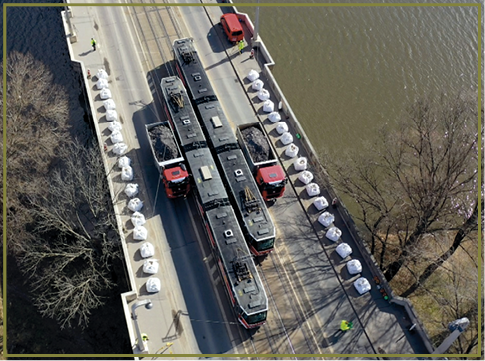
Loads on arch 2 with maximum concentration on the 2 central lanes
For an urban bridge of this type, this load capacity can be considered quite satisfactory and adequate. Thus at the end of 2020, TSK announced and published a public tender for complete renovation of the whole Libeň bridge complex including, aside from new construction of a number of the bridge structures, preservation of the main arch bridge V 009 and the arch flood bridge X 656.
With a proper design and execution of the repairs (reconstruction) and subsequent regular maintenance, the overall durability of the original materials can be increased, as can the remaining service life of the arch bridges as a whole. This will thus preserve a unique testimony to the technical prowess and skill of our predecessors.
* summary of information taken with the permission of the authors from the material of the Klokner Institute.
Troja footbridge [TSK]
The Troja footbridge connects the bank of Císařský ostrov with the bank of the Troja municipal district near the Troja chateau and the zoological garden. The new footbridge with a width of 4 metres is designed for pedestrians, cyclists and, if need be, for integrated rescue system vehicles of up to 3.5 tonnes.
The length of the footbridge is 256 metres and is located above the level of a 20-year flood. In case of flood conditions, it is possible to lower the railings on the lower outer segments. The main load-bearing structure of the bridge consists of a steel backbone made of a circular tube with a diameter of 914 mm. The walking and riding surface of the bridge is made of tropical AZOBE wood, including the railings with integrated LED lighting. The foundation of the pillars is designed to be deep on drilled piles with a diameter of 900 mm. The service life of the bridge has been designed to be 100 years.
The bridge will be monitored online for its whole service life by special sensors and its technical condition will be supervised non-stop. There are devices installed that read the tilt in the areas above the supports, which allows the twisting of the load-bearing structure to be monitored at these sites for individual loads and thus assess whether the bridge is behaving in accordance with the anticipated computational analysis. There are also meteorological sensors here to read the temperature, as well as laser meters for monitoring dilatation – i.e. the shortening and stretching of the bridge.
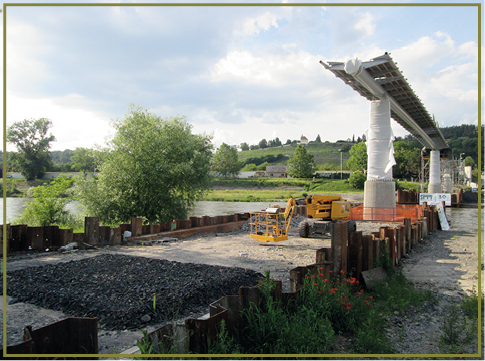
Troja footbridge after installation of the central segment
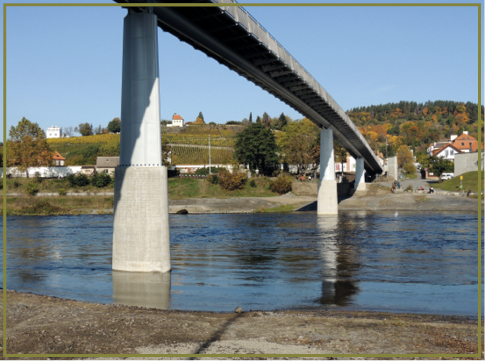
The new Troja footbridge after completion
Reconstruction of Negrelli Viaduct [SŽ]
This was the first major repair of this stone Empire viaduct from 1850 with a length of 1 150 metres, which up until the start of the 20th century was the longest railway bridge in Europe. Due to the fact that the viaduct reconstruction took place with maximum use of original materials and technology, its heritage value was successfully preserved. Work on the viaduct began in April 2017. A total of 100 brick, sandstone and granite arches were reconstructed, of those eight crossing the Vltava. A total of 19 arches had to be completely taken apart and reassembled. For seven of them it turned out that they were in worse condition than was originally anticipated. The railway track bed and superstructure both underwent modernisation, which means that the track speed will have increased from 40 to 60 km/h and the ride will be calmer and smoother. Anti-vibration mats were also used, which help reduce the noise levels in the immediate vicinity of the viaduct. The newest bridge structures from the last century on the streets Prvního pluku and Křižíkova were also replaced. Replacing the existing signalling and communication equipment with modern electronic devices resulted in increased safety and fluidity of the double-track line, which can now handle as many as 14 pairs of trains per hour. The bridge is an integral part of the flood protection system, as the bridge pillars now include a construction which can be fit with mobile barriers in case of impending danger.
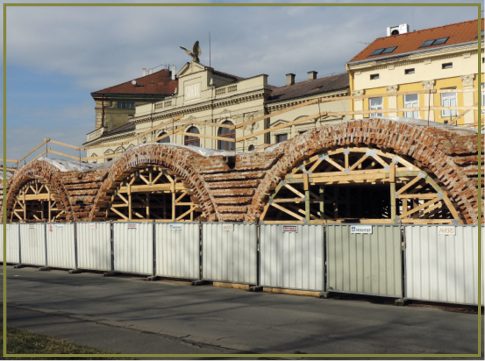
Reconstruction of Negrelli Viaduct
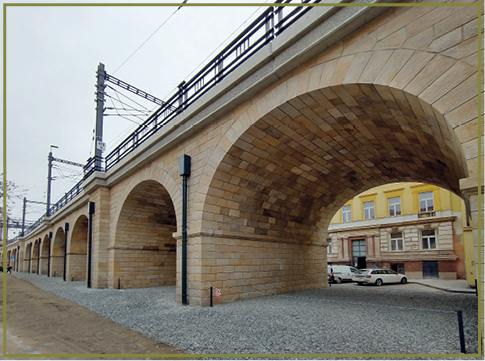
The viaduct's sandstone arches following repairs
Diagnosis and repair of part of Hlávkův most [TSK]
A detailed diagnostic study was conducted on Hlávkův most in 2018 and 2019. The main objective was to establish the bridge's load capacity, assess its structural condition and test the options for repairing it in terms of feasibility and durability. The final report also included a plan for managing and monitoring bridges until reconstruction and a structural historical study.
The results of the study state that with properly conducted repairs, and in particular subsequent regular maintenance (regularly renewing the impregnation, conducting local repairs, etc.) the original materials of the bridges could last 50 years or more.
Based on the results of the complete diagnostic, TSK decided to replace the most damaged transition plates on Hlávkův most. In terms of the bridge complex, this specifically concerned beam bridge V 011 over the navigation channel. The length of the repaired part was roughly 107 metres and was located in the left lane heading into the centre. The carriageway layers were disassembled, the damaged prefabricated plates demolished, the beam bridge brackets rehabilitated, new plates installed and the fusible asphalt insulation strips were re-insulated.
K Výtopně bridge [TSK]
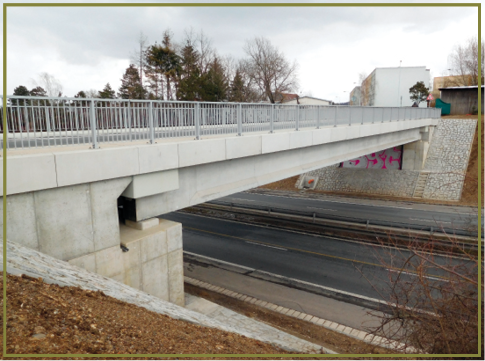
Bridge on the street K Výtopně
The extensive works included demolition and construction of a new X 088 K Výtopně bridge, which connects the street K Výtopně on the Zbraslav side with the ramp onto the street Strakonická, over which the bridge passes. A total reconstruction was elected due to the impossibility of salvaging the lower and load-bearing structure of the original bridge. The demolition of the load-bearing structure only lasted eighteen hours, during which Strakonická had to be closed entirely. The proposed service life of the new structure is 100 years.
It is a prestressed beam structure with a clearance of 33.5 m and a width of 9.6 m without a central pillar. The lower structure consists of the foundation swaths based on piles. The load-bearing structure is formed of five prefabricated prestressed reinforced concrete girders and reinforced concrete coupling slabs made of C 30/37 concrete reinforced with B500B steel.
The bridge deck ends with low cross-pieces on the supports. Both sides of the road have reinforced concrete monolithic ledges with prefab faces. There is a steel railing on the ledges of 1.1 metres in height with a vertical filling.
The rain sewerage of the bridge leads to drainage basin with a spillway to the drainage gutter of the motor road and subsequently through the street drains into the sewer.
Set of works on the Jižní spojka [TSK]
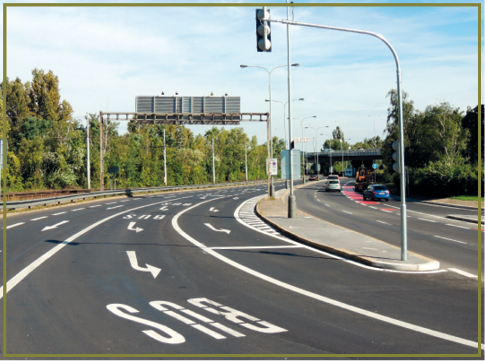
Ongoing maintenance of Modřanská
Due to deformation of the road surface, work on this road entailed milling 100 mm of the slow lane and subsequently replacing it with the same thickness of a combination of bituminous cover with a surface from poured asphalt (60 mm ACL 225 and 40 mm MA 16PMB). Furthermore, damaged guardrails were repaired and road markings added. The segments Vídeňská – 5. května (ZAPA) and NN4315 – Sulická were done on the westbound side. Continuous maintenance was also carried out on three on/off ramps from the Jižní spojka (Chodovská, V Podzámčí and Modřanská). The construction work comprised milling the existing carriageway to 100 mm, rehabilitating the base layers and re-laying a new surface.
| Overview of other road construction, refurbishment and repairs in 2020 |
| Name [investor] |
Description |
Refurbishing of Modřanská
[TSK] |
- After a break for the winter, refurbishing of the street Modřanská continued in the section Údolní – Branická. As part of ongoing maintenance, the road was resurfaced, damaged street drains were replaced and sewers repaired primarily using trenchless technology. Furthermore there was local levelling of kerbs that stuck out in terms of height or direction, repairs to bus stops and adjacent boarding areas and rectification of surface evidence of underground infrastructure.
- Work was coordinated with structural modifications and refurbishing of traffic signals at the intersection with Údolní and the intersection with the Barrandovský most ramps. Work at this intersection included for example changing the position of the central island, building a new connecting lane from the Barrandovský most ramp onto Modřanská heading towards the centre, adding a sidewalk including barrier-free modifications and shifting the street drains and poles.
|
Branická noise
[TSK] |
- Following up on the stage from the previous year, during which parking spots were installed and the sidewalk repaired, refurbishing of the street Branická continued. The work included replacement of the existing road surface made of large granite paving stones, which caused excessive noise, with a surface made of a compacted asphalt mix. In selected segments (residential zone, raised intersection surface, parking bays, driveways and loading/unloading parking spots), a paved surface was retained. The existing sidewalk surface made of poured asphalt was replaced with stone mosaic. New trees were planted, benches installed and drainage modified.
- Work was coordinated with the works of other investors (reconstruction of public lighting, laying of new infrastructure by individual infrastructure managers). It was not possible to drive through the renovated segment during construction, with only local access preserved.
|
Reconstruction of bridge Y 002 Na Zlíchově
[TSK] |
- This was reconstruction of the bridge that takes the local road and tram track between Smíchov and Hlubočepy across railway track no. 171. Construction work included renovating the bridge and the associated moving of the collector and technical infrastructure leading along the bridge structure. During reconstruction of the bridge superstructure, the insulation and carriageway layers were replaced and the expansion joints and other bridge accessories refurbished. The bottom structure was also rehabilitated.
- The work was coordinated with an overhaul of the tram tracks. At the same time the bridge has been prepared for the tram track and sidewalks to connect to the future Dvorecký most.
|
Refurbishing of Chodovská
[TSK] |
- In light of the scope of the work, it has been divided into several stages that will continue into the coming year. In 2020, repairs were done on the section U Plynárny – Jižní spojka. Construction commenced with repairs to the connectors under the tram track carried out using microtunnelling. The construction of the existing sidewalk was also repaired. The new road surface is made of compacted asphalt mixture. The project also included repairs to 58 sewer drains. Repairs were predominantly made by the trenchless method, which is effective and less time-consuming than through excavation. The work also included modification to bus stops.
|
Renovation of Karlovo náměstí circuit
[TSK] |
- The first stage of renovations on the roads and sidewalks around the circumference of Karlovo náměstí took place, primarily comprising repairs to the intersection Karlovo náměstí x Resslova. The project was done in coordination with modifications to the traffic signals. The construction work also included modifications to the corners of the intersection, barrier-free pedestrian crossings were installed and the traffic space was reorganised horizontally. The carriageway has an asphalt surface and the sidewalks use mosaic paving. Drainage was also modified. Thanks to this project, the intersection can be traversed by pedestrians barrier-free in all directions and the underpasses do not need to be used to get across it.
|
Refurbishing of Bucharova
[TSK] |
- In 2020, a significant part of the reconstruction work on Bucharova in the segment Jeremiášova – Šafránkova took place, following up on work in the previous year and to be completed in the coming year. The project saw milling with subsequent replacement of the bituminous layer. Kerbs were flattened, bus stop surfaces repaired, street drains rectified, problems with roads sinking removed and new road markings added. The work is coordinated with PVS and DPP.
|
Refurbishing of Koněvova
[TSK] |
- In 2020, the phase of repairs to the segment Husitská – Rokycanova took place. Work included changing the position of the sidewalk kerbs, modifying the width of the main traffic area and installing parking bays, thereby eliminating the dangerous practice of parking on sidewalks. The carriageway is asphalt, the parking bays made of large granite paving stones and the sidewalks stone mosaic. The work included modifying the drainage, shifting the underground infrastructure, landscaping and new furniture.
|
Refurbishing of Jungmannova
[TSK] |
- Work began in 2019 on the section Palackého – Vodičkova. After a break for the winter, work continued along the whole length of the street in 2020 and included new construction of the carriageway and sidewalks, installation of kerbs, rehabilitation of the subgrade at sites of sinking, and repairs to damaged street drains and their sewer connections. The road surface is bituminous, the sidewalks made of mosaic paving, and entryways granite paving. New greenery was planted.
|
Ongoing maintenance of Jana Želivského
[TSK] |
- Ongoing maintenance of the street Jana Želivského in the segment Koněvova – Olšanská consisted of milling the surface to a depth of 100 mm and subsequently replacing it to the same depth with a surface layer of silent asphalt, which reduced noise by 3-5 dB. Surface signs of the underground infrastructure were also rectified and the street drains repaired.
|
Refurbishing of Evropská
[TSK] |
- Refurbishing in 2020 took place in the segment Horoměřická – Thákurova. The carriageway was repaired according to the diagnostic, which meant removing the asphalt layers and laying down new layers with a total thickness of 50–150 mm. Also as part of the works, new road markings were added and the measuring points and holes from the drills from the metro being drilled were removed.
|
Repairs to part of Jiráskův most
[TSK] |
- Repairs took place to the structural part of the sidewalks in both directions of the bridge. The railings were cleaned and rehabilitated. The damaged carpet expansion joints from the individual panels were removed and replaced with new ones, which were installed onto a concrete and steel bed. The expansion joints were installed at the existing vertical and horizontal slope.
|
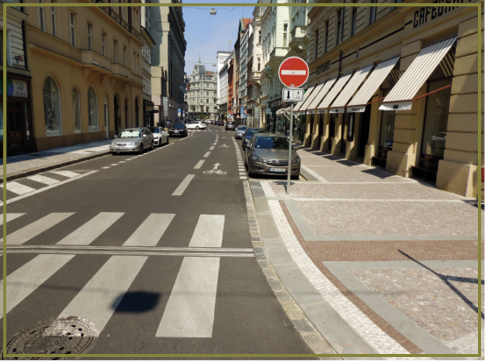
Jungmannova following complete refurbishing
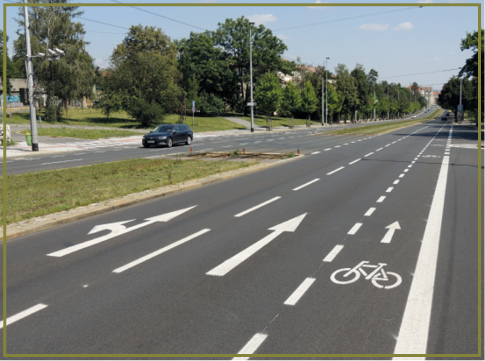
New road surfaces on Evropská
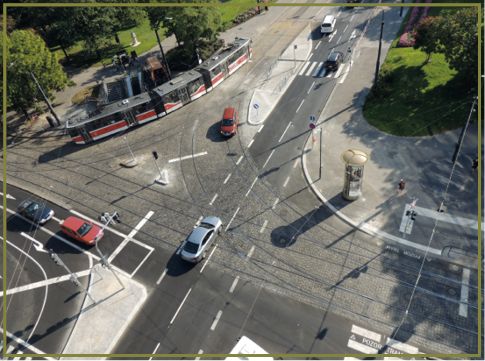
Karlovo náměstí intersection after the overhaul
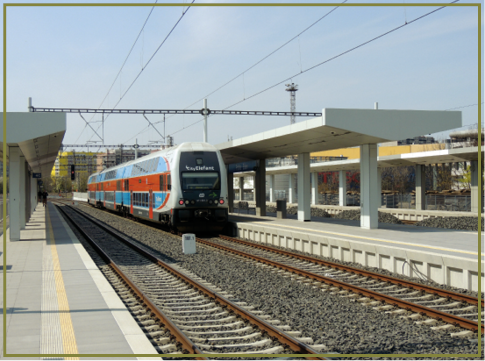
New Praha-Eden railway stop
| Overview of most important refurbishments and repairs in public transport in 2020 |
| Name [investor] |
Description |
Tram track refurbishment Starostrašnická – V Olšinách
[DPP] |
- From the Vinice intersection up to in between the entrances to the Strašnice depot, the track was replaced with a classic construction with a grooved rail with concrete or wooden sleepers and asphalt covering. For the rest it was replaced with a new construction of a fixed track with grooved rail with flexible fastening on a concrete slab. The surface was asphalt, by the Strašnická stop paved. Anti-vibration mats were added. On the street V Olšinách, the track was set up on reinforced concrete sleepers on a gravel bed using grooveless rails and a grass-covered surface. TSK built new boarding platforms at the Vozovna Strašnice stops in the form of extended sidewalks.
|
Tram track refurbishment on Nádražní
[DPP] |
- The tram track underwent refurbishing in the segment Smíchovské nádraží – Křížová. On a section of approx. 900 metres, the tram track was shifted west towards the railroad track, thereby separating tram traffic from road traffic. The construction work included removing the original large-scale panels and replacing them with a new construction with an open superstructure. The carriageways, sidewalks and boarding platforms at the Lihovar stops were also refurbished in coordination with TSK. The narrow neck of Nádražní was also expanded, so now the tram track and two lanes for other traffic fit next to each other.
|
Tram track refurbishment Hlubočepy – Barrandov
[DPP] |
- After 16 years of continuous operation since construction, repairs were made to the tram tracks in the segment Hlubočepy – Sídliště Barrandov. For the majority of the stretch, grooveless rails were used, while on the bridgeheads of the flyovers, more comfortable railway-type joints were used and the expansion joints were refurbished. The stop structures and underpass portals were cleaned and repaired, as were the surfaces on the access ramps, stairs and stops. The lighting was modernised and energy-saving LED lights are now used on the overhead line gates and stops.
|
Optimisation of track segment Praha-Hostivař – Praha hl. n.
[SŽ] |
- Track 221 was moved as part of the work and is now routed along the south edge of the former Praha-Vršovice marshalling yard, and now has four tracks. The stop Praha-Eden was built to replace the decommissioned Praha-Strašnice stop. Thanks to the straightening of the track, which shortened it by 232 metres, and thanks to the speed increasing to 120 km/h, the ride time has been reduced by up to three minutes. In the coming year the station Praha-Záhradní Město will be opened, and renovations to the Praha-Vršovice station and other work will be completed.
|
Tram track refurbishment on Na Veselí and Soudní
[DPP] |
- The existing large-format panels were replaced with a fixed track with W-tram fastenings. At the same time, anti-vibration mats and rail lubricators were installed. The track constructions and curves in front of the Pankrác depot were replaced. The Na Veselí stop is now barrier-free.
- As part of refurbishing of adjacent sections of existing tracks, around 250 metres of double tram track was constructed, which at the end leads to a dead end, where the final stop Pankrác has been built.
|
Tram track refurbishment on Sokolovská
[DPP] |
- Refurbishment took place in the section Poliklinika Vysočany – Náměstí OSN. The original track made of large-scale panels was replaced with a concrete slab with W-tram fastenings, and in part with a construction on reinforced concrete sleepers with asphalt covering. The stop Nádraží Vysočany was also shortened heading into the centre (TSK), the island heading into the centre was refurbished, the drainage was modified using gutter drainage channels and some overhead line poles were replaced.
|
Renovation of the Opatov metro station
[DPP] |
- As part of modernisation, new drop ceilings, wiring and ventilation were installed and the hydroinsulation of the ceiling panel was repaired, with it first being necessary to remove all the layers of soil up to the boarding platform ceiling. It was the first station in the Prague metro to have LED lighting technology installed. The wall and floor tiles were repaired and cleaned. Two new lifts were built. The first is incorporated into part of the fixed staircase, while the second provides transport from the vestibule level to the level of the bus stops on Chilská.
|
Tram track refurbishment on Karlovo náměstí
[DPP] |
- The project took place in three stages: the branching off Spálená, the branching off Ječná and replacing part of the track construction on Tylovo náměstí off Ječná, and the branching from Moráň and replacing the track crossing at Moráň. The track on the street Na Moráni was also repaired, with four turns replaced and two cuts made.
|
| Other repairs and refurbishments in public transport |
- Metro: On the C line, the end-of-life wooden sleepers were replaced with reinforced concrete ones during several closures. Repairs to the Na Knížecí vestibule began at Anděl metro station.
- Trams: Construction of the Sídliště Barrandov – Holyně track began with an initial forty metres.
- Railway: Optimisation of the track section Mstětice (not incl.) – Praha-Vysočany on track 232 began. Optimisation of track 171 in the section Praha-Smíchov – Praha-Radotín began.
|
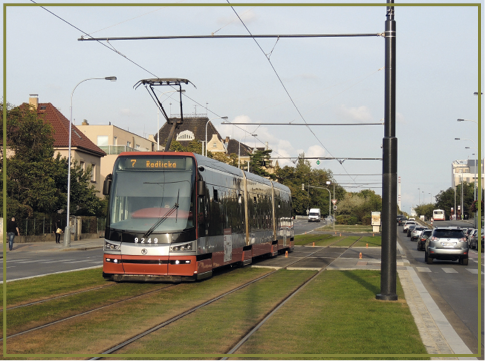
Reconstructed tram track in street V Olšinách
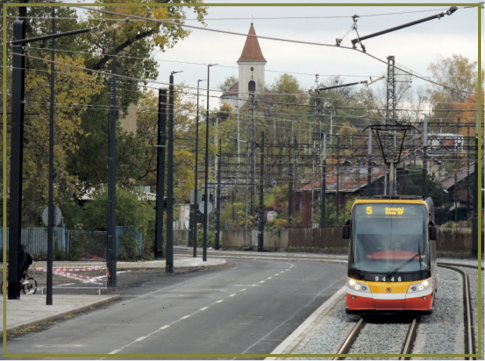
A completely new arrangement of Nádražní street with side leadership TT
The City of Prague Technical Administration of Roads, as the administrator of most roads and road accessories in the city, is responsible for keeping them in satisfactory working order. It therefore provides for all necessary road repairs, cleaning, and winter and summer maintenance and operation.
These activities are financed by the City of Prague from the current and capital expenditure budget, and in some cases with contributions from SFDI or the municipal districts.
In 2020, CZK 4 089 186 000 was spent via TSK on repairs, maintenance, operations and summer and winter maintenance. Capital expenditures totalled CZK 1 626 692 000.
















